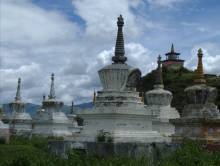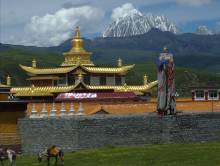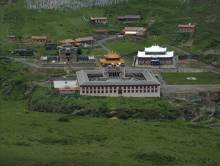Tibetan Places > Ba Lhagang > Local Sites in Ba Lhagang
Significant Places to Visit in Lhagang
Lhagang Monastery / ལྷ་སྒང་དགོན་མཐོང་གྲོལ་བསམ་གྲུབ་གླིང་ཆོས་སྡེ་ཆེན་པོ།
 White stūpas at Lhagang Monastery
White stūpas at Lhagang Monastery
Upon arriving in Lhagang, it is likely that Lhagang Monastery will be the first major sight you encounter. In its earliest period after its founding in the seventh century, Lhagang Monastery likely consisted of no more than a single temple. Built as the last of 108 temples ordered for construction by Songtsen Gampo, the temple was (and still is) home to Lhagang’s famous Jowo Buddha image, a statue historically related to the revered Jowo image located at the heart of Tibet in Lhasa’s Jokhang Temple. In the centuries after it was founded, the Jowo temple (and monastery that was built around it) have had a central place in the area’s landscape and defining narratives. While early in its history the monastery was part of the Kagyü lineage, it eventually came under the influence of the Sakyas and retains that affiliation today.
Sadly, Lhagang Monastery – including all but the face of its precious Jowo statue – were destroyed during the Cultural Revolution. It was not until the early 1980s that the local community was permitted to rebuild the monastery. Today, the rebuilt monastery complex consists of a handful of buildings surrounding a small courtyard. The main assembly hall sits directly opposite the main entrance. Adjacent to the assembly hall on the left is a temple housing a beautifully-made statue of Chenrezik (Sanskrit: Avalokiteshvara). To the right is the chapel that is home to the (now reconstructed) Lhagang Jowo statue. On the right side of the courtyard toward the front of the complex is the Druptop Temple. Opposite that building to the left is a temple devoted to Padmasambhava. Monastic quarters surround the courtyard on either side. Behind the monastery are hundreds of white stūpas, the largest (and newest) of which holds the relics of Khenpo Chödrak, a lama from Dzokchen Monastery who was responsible for establishing Lhagang’s Nyingma monastic college during the 1980s and 1990s and ushering in a new and vibrant generation of Buddhist study and practice in the region.
Lhagang Monastery attracts Tibetan pilgrims from all over Kham as well as thousands of Chinese and international sightseers. Particularly popular is the elaborate three-day cham or ritual dance ceremonies which typically take place during late July or early August each year.
Minyak Golden Stūpa / མི་ཉག་སེར་གྱི་མཆོད་རྟེན།

The Minyak Golden Stūpa has come to be an icon for the town of Lhagang and is often the first major Tibetan temple Chinese tourists visit upon arriving on the Tibetan plateau. Built during the late 1990s by Dorjé Tashi Rinpoché, the Golden Stūpa is quite unlike any temple of its kind. Schematically the entire complex that hosts the stūpa aims to resemble the layout of a mandala or sacred Buddhist cartography of the cosmos in the same tradition as the Samyé Monastery in Central Tibet. Quite unlike Samyé, however, are its modern influences. The inside of the main temple makes use of a great deal of modern marble and ceramic building materials, giving it a polished feeling that is unfamiliar to most Tibetan temples (most of which use wood). Surrounding the main temple are residential buildings which house students, guests, and assistants of Dorjé Tashi Rinpoché. While the Golden Stūpa has become an important tourist destination, it also serves as the organizational and command center for Dorjé Tashi who, together with partners in mainland China and abroad, is actively engaged in numerous humanitarian projects aimed at promoting Tibetan culture and helping poor and orphaned Tibetan children, such as the Xikang Welfare School and the Kham Cultural Library. It is said the presence of the Golden Stūpa at the center of the Lhagang Grasslands fulfills a long time-prophecy that a stūpa would be built there.
Nyingma Monastic College
 The main assembly halls at
The main assembly halls at
the Nyingma Monastic College
Located just more than half a mile to the west of the main town, the Nyingma monastic college consists of a modest groups of buildings that house monks engaging in full-time study in scholastic Buddhist texts. Unlike Lhagang Monastery, in which the monks mainly conduct rituals and ceremonies, the monks at the monastic school are engaged in a seven-year curriculum aimed at mastering the finer points of Buddhist logic, philosophy, and discourse. Like most modern monastic colleges, the monks spend their time memorizing and debating Buddhist texts. Many advanced students who have finished the seven-year curriculum, as well as senior members of the monastic community, are actively engaged in retreat in houses above the college on the hillside. Drukdrak Lama and Dorjé Tashi Rinpoché – two of the most important lamas living around Lhagang – both studied at Lhagang Monastery with Khenpo Chödrak, a highly influential lama from Dzokchen Monastery who was instrumental in starting the monastic college during the 1980s.
Sakya Monastic School
The Sakya Monastic school sits prominently on the hillside across the river from town in between the Manjushri and Chenrezik hills. The monastic school is a relatively new project of Lhagang Monastery and was built with the intention to provide an opportunity for the monks of Lhagang Monastery to receive a scholarly education according to the Sakya tradition. Lhagang Monastery itself has no formal scholarly curriculum and focuses almost solely on chanting and performing rituals for the local community. In contrast to the Nyingma Monastic College which has been governed by a series of lamas educated solely in Tibet, many of the teachers at the new Sakya school are monks who have recently returned from India where they were educated at monastic schools in the Tibetan diaspora community.
To get to the monastic school, cross the river at the main bridge and then turn right and cross over the stream that feeds into main river. Follow the road as it leads you back along the main river and along the base of Chenrezik Mountain. Within a few minutes you’ll soon arrive at school.